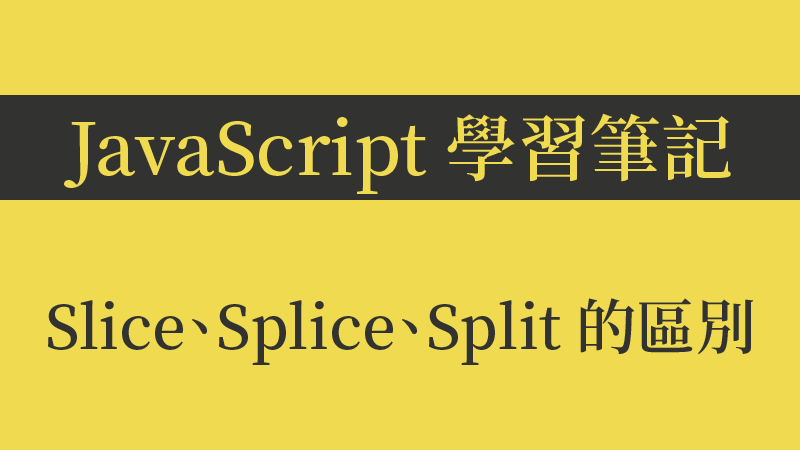JavaScript筆記 目錄
前言
Slice、Splice、Split 這幾個方法都是 S 開頭,因此若不熟悉很容易搞混,但它們又是處理 陣列 或 字串 常見的方法。
slice 提取
陣列和字串都有 slice() 方法。
1. Array.prototype.slice()
陣列的 slice() 會回傳一個指定索引範圍的新陣列(不改變原陣列)。
1
|
arr.slice([begin[, end]])
|
begin:起始索引,若省略預設為 0;end:停止索引(不包含自己),若省略預設為 arr.length;- 可以使用負數索引,從末項開始倒數。
1.1 範例
1
2
3
4
5
6
7
8
9
10
11
12
13
|
const arr = [0, 1, 2, 3, 4, 5];
// 無參數 0 ~ (arr.length - 1)
console.log( arr.slice() ); // [0, 1, 2, 3, 4, 5]
// begin 2 ~ (arr.length - 1)
console.log( arr.slice(2) ); // [2, 3, 4, 5]
// begin end 2 ~ (3 - 1)
console.log( arr.slice(2, 4) ); // [2, 3]
// 負數 (arr.length - 2) ~ (arr.length - 1)
console.log( arr.slice(-2) ); // [4, 5]
|
1.2 常見用法
用法一:淺拷貝陣列
1
2
|
const arr = [0, 1, 2, 3, 4, 5];
const temp = arr.slice();
|
ES6 前沒展開運算子,都是使用 slice() 來淺拷貝陣列。
用法二:從陣列前端、末端取 N 個元素使用
1
2
3
4
5
6
7
|
const arr = [0, 1, 2, 3, 4, 5];
const first4 = arr.slice(0, 4);
console.log( first4 ); // [0, 1, 2, 3]
const last4 = arr.slice(-4);
console.log( last4 ); // [2, 3, 4, 5]
|
用法三:獲取陣列中的某段長度的子陣列
1
2
3
4
5
6
7
|
const arr = [0, 1, 2, 3, 4, 5];
function pullSegment(arr, begin, len) {
return arr.slice(begin, begin + len);
}
console.log( pullSegment(arr, 2, 3) ); // [2, 3, 4]
|
用法四:縮短陣列長度
1
2
3
4
|
let arr = [0, 1, 2, 3, 4, 5];
arr = arr.slice(0, 3);
console.log( arr ); // [0, 1, 2]
|
2. String.prototype.slice()
字串的 slice() 會回傳一個指定索引範圍字元的新字串(不改變原字串)。
1
|
str.slice(beginIndex[, endIndex])
|
用法基本上與陣列的 slice() 差不多,直接看範例。
2.1 範例
1
2
3
4
5
6
|
const str = 'Hello world!';
console.log( str.slice() ); // 'Hello world!'
console.log( str.slice(2) ); // 'llo world!'
console.log( str.slice(2, 4) ); // 'll'
console.log( str.slice(-2) ); // 'd!'
|
2.1 類似方法
類似的方法還有 substring()、substr() 但 substr() 它不屬於 JavaScript 核心規範,所以如果是非瀏覽器的環境可能無法使用,所以盡可能避免使用。而 substring() 因為第二個參數小於第一個參數時,會自動換位,而且不支援負數,沒有 slice() 來的彈性。
Splice 拼接
Array.prototype.splice() 藉由刪除既有元素或加入新元素來改變一個陣列的內容,並回傳一個包含被刪除的元素陣列。
1
|
array.splice(start[, deleteCount[, item1[, item2[, ...]]]])
|
start:要插入或刪除的索引位置;
- 可以使用負數索引,從末項開始倒數
- 若大於
arr.length 則會被設為 0
deleteCount:要刪除的元素數量;
- 若省略或大於
arr.length,start 後的元素都會被刪除(包含 start)
item1, item2, ...:要插入的元素內容。
1. 範例
從指定索引位置開始,刪除所有元素(含指定索引):
1
2
3
4
5
|
const arr = [0, 1, 2, 3, 4, 5];
const removed = arr.splice(2);
console.log(arr); // [0, 1]
console.log(removed); // [2, 3, 4, 5]
|
從指定索引位置開始,刪除指定數量的元素:
1
2
3
4
5
|
const arr = [0, 1, 2, 3, 4, 5];
const removed = arr.splice(2, 2);
console.log(arr); // [0, 1, 4, 5]
console.log(removed); // [2, 3]
|
從指定索引位置開始,刪除指定數量的元素,並插入元素:
1
2
3
4
5
|
const arr = [0, 1, 2, 3, 4, 5];
const removed = arr.splice(2, 3, 'aa');
console.log(arr); // [ 0, 1, 'aa', 5 ]
console.log(removed); // [2, 3, 4]
|
2. 常見用法
移除陣列指定元素:
1
2
3
4
5
6
7
8
|
function removeElement(arr, index) {
arr.splice(index, 1);
return arr;
}
const arr = [0, 1, 2, 3, 4, 5];
removeElement(arr, 2);
console.log(arr); // [0, 1, 3, 4, 5]
|
split 分割
String.prototype.split() 方法會依照指定規則分割字串,並回傳一個陣列,內容為拆分的字串。
1
|
str.split([separator[, limit]])
|
separator:字串或正則表達式,從符合的字元位置分割,若為空字串,則分割每個字元;limit:回傳的分割元素數量。
1. 範例
1
2
3
4
5
6
7
8
9
|
const monthString = 'Jan,Feb,Mar,Apr,May,Jun,Jul,Aug,Sep,Oct,Nov,Dec';
console.log( monthString.split(',') );
// [ 'Jan', 'Feb', 'Mar', 'Apr', 'May', 'Jun', 'Jul', 'Aug', 'Sep', 'Oct', 'Nov', 'Dec' ]
const num = '00000000';
console.log( num.split('', 2) ); // [ '0', '0' ]
|
